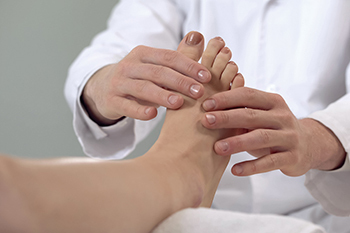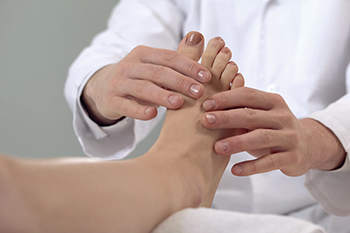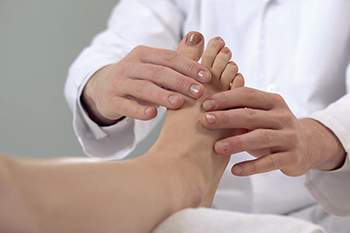
One of the benefits of getting regular foot massages is the overall feeling it can have on the body. It is known to promote blood circulation which may help prevent unwanted foot conditions. Additionally, there are pressure points in the feet that are connected to specific organs in the body, and this can be beneficial in relaxing the muscles and reducing stress. There are various categories of foot massages. A deep tissue massage is done by applying forceful pressure that can reach the muscle layers and connective tissue. This may help people who have endured an injury or who may have painful joints. Diabetic patients can often benefit from having a Thai foot massage performed which may help to increase their range of motion in addition to improving balance. The most common form of massage is known as the Swedish foot massage and the feet can become energized. If you are interested in foot massages and would like to know which one is best for you, please consult with a podiatrist who can answer any questions you may have.
Foot therapy is often necessary for those recovering from either foot deformities or foot injuries. If you have concerns regarding therapy, consult with Brian Shwer, DPM from Southaven Foot Clinic. Our doctor can provide the care you need to keep you pain-free and on your feet.
Most Common Injuries
People who are active or athletes are prone to a variety of injuries. Therefore, it is often important to take part in physical therapy in order to quickly get back on the right track.
What to Do When Injured
Physical Therapy – This specialized treatment will focus on the affected area, speeding up recovery and the overall healing process. It is a proven method that has helped millions of people return from any injury.
During physical therapy you will undergo regimented training to get back into full form. Training is often very difficult, especially at first when the foot feels weak. Physical therapy often involves:
Basic stretching and twisting exercises – getting the feet’s mobility and flexibility up.
Massaging – the therapist will massage the injured area in order to activate the muscles and relax them.
Strengthening Exercises – this allows the muscles in the affected area to regain their full strength, a vital step towards full recovery.
If you have any questions please feel free to contact our office located in Southaven, MS . We offer the newest diagnostic tools and technology to treat your foot and ankle needs.

The joints in the feet can be negatively affected by the autoimmune condition known as rheumatoid arthritis. This is often referred to as RA, which is the abbreviation. The common symptoms that are often associated with this type of arthritis can include swelling, pain, and a limited range of motion. Many patients have difficulty in completing daily activities as a result of the intense pain and this can affect more than the joints. The cartilage, ligaments, and tendons may become painful and can progress quickly. Some of the foot issues that may develop from RA are bunions, claw toes, and flattened arches. Some people can have their circulation affected and this can lead to nerve damage. RA can become triggered by an existing infection, stress, and lack of sleep. This condition can produce serious complications to the feet and it is strongly suggested that you are under the care of a podiatrist who can help you to manage rheumatoid arthritis.
Because RA affects more than just your joints, including the joints in your feet and ankles, it is important to seek early diagnosis from your podiatrist if you feel like the pain in your feet might be caused by RA. For more information, contact Brian Shwer, DPM of Southaven Foot Clinic. Our doctor will assist you with all of your podiatric concerns.
What Is Rheumatoid Arthritis?
Rheumatoid Arthritis (RA) is an autoimmune disorder in which the body’s own immune system attacks the membranes surrounding the joints. Inflammation of the lining and eventually the destruction of the joint’s cartilage and bone occur, causing severe pain and immobility.
Rheumatoid Arthritis of the Feet
Although RA usually attacks multiple bones and joints throughout the entire body, almost 90 percent of cases result in pain in the foot or ankle area.
Symptoms
Diagnosis
Quick diagnosis of RA in the feet is important so that the podiatrist can treat the area effectively. Your doctor will ask you about your medical history, occupation, and lifestyle to determine the origin of the condition. Rheumatoid Factor tests help to determine if someone is affected by the disease.
If you have any questions please feel free to contact our office located in Southaven, MS . We offer the newest diagnostic and treatment technologies for all your foot and ankle needs.

Foot drop is a symptom of another condition, generally related to some form of nerve injury. It becomes apparent when a patient is unable to lift the foot enough to clear the floor or ground while walking. The foot then drags along behind, causing a type of shuffling gait. Someone with foot drop may raise the knee higher with each step, which looks like marching. Further, the foot often slaps the ground when it is lowered, as the patient is unable to control the movement. Among the many conditions that result in foot drop are a peroneal nerve injury, an ankle injury, muscular dystrophy, a stroke, or diabetes. Even something as simple as crossing the legs while sitting can constrict the peroneal nerve and cause numbness and foot drop. A podiatrist can conduct a complete examination to determine the cause of foot drop and explore the range of treatment options available to you.
If you have any concerns about your feet, contact Brian Shwer, DPM from Southaven Foot Clinic. Our doctor can provide the care you need to keep you pain-free and on your feet.
Biomechanics in Podiatry
Podiatric biomechanics is a particular sector of specialty podiatry with licensed practitioners who are trained to diagnose and treat conditions affecting the foot, ankle and lower leg. Biomechanics deals with the forces that act against the body, causing an interference with the biological structures. It focuses on the movement of the ankle, the foot and the forces that interact with them.
A History of Biomechanics
Modern technological improvements are based on past theories and therapeutic processes that provide a better understanding of podiatric concepts for biomechanics. Computers can provide accurate information about the forces and patterns of the feet and lower legs.
Understanding biomechanics of the feet can help improve and eliminate pain, stopping further stress to the foot.
If you have any questions please feel free to contact our office located in Southaven, MS . We offer the newest diagnostic and treatment technologies for all your foot and ankle needs.

The ankle is a necessary and critical part of the human body. The ankle joint allows the foot to move in different directions and makes walking and running possible. However, the ankle can be very susceptible to suffering from certain kinds of injuries. For example, broken ankles can be a serious threat to your health. Importantly, broken ankles are distinctly different from sprained ankles. When an individual breaks their ankle, the bones become essentially fractured. This is to say that bones such as the tibia, fibula, or talus can become fractured. If you have a broken ankle, you might experience several different symptoms. Commonly, an individual might experience feelings of pain or even swelling. Contrastingly, a person who sprains their ankle injures the ligaments surrounding the ankle, not the bones. When a person sprains their ankle the tissues become strained or overly stretched. Although these two injuries are different, it is possible to experience both at the same time in a very severe ankle injury. If you are worried about the health of your ankles, contact a podiatrist for more information about broken and sprained ankles.
Broken ankles need immediate treatment. If you are seeking treatment, contact Brian Shwer, DPM from Southaven Foot Clinic. Our doctor can provide the care you need to keep you pain-free and on your feet.
Broken Ankles
A broken ankle is experienced when a person fractures their tibia or fibula in the lower leg and ankle area. Both of these bones are attached at the bottom of the leg and combine to form what we know to be our ankle.
When a physician is referring to a break of the ankle, he or she is usually referring to a break in the area where the tibia and fibula are joined to create our ankle joint. Ankles are more prone to fractures because the ankle is an area that suffers a lot of pressure and stress. There are some obvious signs when a person experiences a fractured ankle, and the following symptoms may be present.
Symptoms of a Fractured Ankle
If you suspect an ankle fracture, it is recommended to seek treatment as soon as possible. The sooner you have your podiatrist diagnose the fracture, the quicker you’ll be on the way towards recovery.
If you have any questions, please feel free to contact our office located in Southaven, MS . We offer the newest diagnostic and treatment technologies for all your foot care needs.